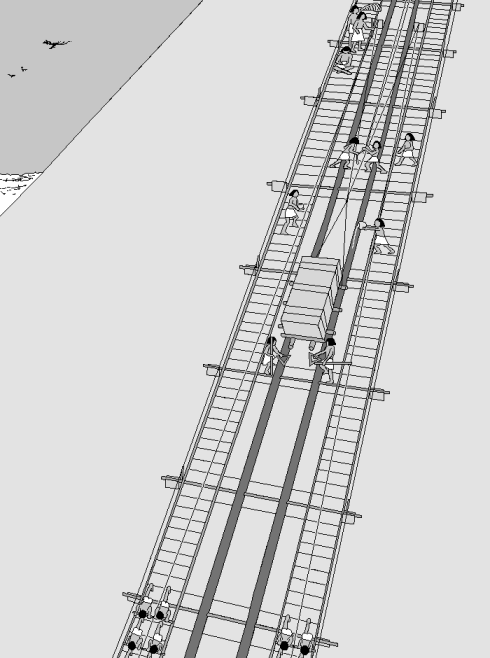How were the pyramids built?
The rope roll station
A new method by Franz Löhner
Transport up the flank of the pyramid with Löhner's rope roll
On this page we take a look at how the whole assembly of sledge, tracks
and rope rolls works, if installed on the 52° angled flank of Khufu's
pyramid.
Configuration of track system - Rope rolls on
pyramid flank - Anchoring the tracks - Anchoring
the rope roll - Starting at the foot - Changing
ropes - Rope roll station on edge - Arrival
of stone on plateau - Laying the stones -
Safety - Sources
 Configuration of the track system with rope roll stations
Configuration of the track system with rope roll stations
Rope roll station, tracks and haulers on pyramid flank
(illustration R. Zuberbühler)
Click here for version with detailed
explanation / print
version
About the rope roll and about the sledge on tracks there are separate
pages, please read the details there!
![]() Löhner's rope roll
Löhner's rope roll
![]() Transporting the stone blocks using a sledge
on tracks
Transporting the stone blocks using a sledge
on tracks
![]() Calculating the force and kinetic coefficient
of friction necessary
Calculating the force and kinetic coefficient
of friction necessary
 How are Franz Löhners rope rolls used on the pyramid flank?
How are Franz Löhners rope rolls used on the pyramid flank?
| 1. | New | To build the pyramid, several track systems are installed directly on the inclined plane of the pyramid. Further up near the top of the pyramid only a single track is necessary. (doctrine = large transport ramps are built, either ramps leading straight up to the side of the pyramid or winding ramps) |
| 2. | New | The track system consists of tracks and a ladder-like rig installed to left and right of the tracks. Rope rolls are installed in pairs and constitute a rope roll station. Those stations are installed every 30-37 meters of height on the pyramid side. The top most rope roll station on the edge has a more complicated setup. |
| 3. | New | The rope roll (wooden block with a roll) and the tracks and ladder-like rigs are installed and anchored on outer stones which are left protruding, and tied down. |
| 4. | New | The rope roll stations are installed in series so a sledge with a stone can be hauled up over several rope roll stations in one continuous movement, without stopping and restarting. |
| 5. | New | When arriving on the edge of the pyramid plateau, the sledge is tilted and then hauled on tracks to the exact position, where the stone is levered and laid down at its intended place. |
It's important, that the rope roll stations operate in series. Every 30-37m a rope roll station is installed and operated by a team of 55 men (haulers and helpers) A stone, that has to reach the very top of the pyramid (146.59 meters) would pass a total of 4 rope roll stations in one continuous movement until arriving at the top.
First there are a total of five tracks, but because the volume of stones
needed is less with every new layer, they can be reduced over time first
to three tracks, then to a single track which leads up to the very tip
of the pyramid. Of course if you increase the number of track systems
used at the beginning, the time to build the pyramid can be reduced much.
We think, that it was also possible to build the pyramid of Khufu in only
10 to 15 years, if at the beginning all four sides of the pyramid were
used to install tracks and rope roll stations and this without raising
the number of workers too much!
![]() Numbers and figures of the Cheops-pyramid
(pyramid of Khufu) (necessary output)
Numbers and figures of the Cheops-pyramid
(pyramid of Khufu) (necessary output)
![]() Detailed calculations how many workers
were necessary to build the pyramid
Detailed calculations how many workers
were necessary to build the pyramid
 Anchoring the tracks and ladder-like rig on the pyramid flank
Anchoring the tracks and ladder-like rig on the pyramid flank
Franz Löhner suggests a very simple method - the tracks and rails are anchored directly on the stones of the pyramid flank. The position and shape of the anchoring stones have to be planned right from the beginning, when you start building the first stone layer. The position of the track system has to be determined and then special Tura stones (outer casing blocks) are left protruding. Depending on their function the shape of the stone would differ. After finishing the pyramid by laying the pyramidion on its top, the stone bosses were chiseled off and the stone smoothed.
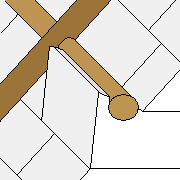 The
tracks are made from logs connected by cross beams. About every two meters
those cross beams are lengthened to the left and right. Special Tura stones
(casing stone) are left standing, they protrude slightly from the otherwise
smooth pyramid side and have been formed in such a way, that the longer
cross beams rest on top and can be tied down and anchored. Now the ladder-like
rig can be attached to the same cross beams further to the left and right
(a similar device was used to hold up the large portcullis slabs in the
kings chamber - illustration)
The
tracks are made from logs connected by cross beams. About every two meters
those cross beams are lengthened to the left and right. Special Tura stones
(casing stone) are left standing, they protrude slightly from the otherwise
smooth pyramid side and have been formed in such a way, that the longer
cross beams rest on top and can be tied down and anchored. Now the ladder-like
rig can be attached to the same cross beams further to the left and right
(a similar device was used to hold up the large portcullis slabs in the
kings chamber - illustration)
The protruding Tura stones prevent, that the tracks and ladder-like rigs
are pulled down by the weight of the stone blocks. The tracks have to
bear not that much of the load, because most of the weight is sustained
by the rope rolls. The ladder-like rig is further secured by a guardrail
made from ropes, so falls can be prevented.
![]() Illustration
of rope roll station and tracks on the pyramid flank
Illustration
of rope roll station and tracks on the pyramid flank
 Anchoring the rope rolls on the pyramid flank
Anchoring the rope rolls on the pyramid flank
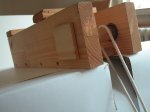 The
rope rolls have to be very well anchored indead, because they
bear most of the load. The weight of the stones plus the sledge
(2800 kg), and at the moment when the friction is surmounted also the
weight of the haulers pulling at the ropes (24 to 48 men = app. 1400 to
3000 kg) is sustained by the rope roll. And this force is transferred
through frictional connection from the rope roll to the underlying stone.
The
rope rolls have to be very well anchored indead, because they
bear most of the load. The weight of the stones plus the sledge
(2800 kg), and at the moment when the friction is surmounted also the
weight of the haulers pulling at the ropes (24 to 48 men = app. 1400 to
3000 kg) is sustained by the rope roll. And this force is transferred
through frictional connection from the rope roll to the underlying stone.
The rope rolls are also anchored directly on the pyramid flank. Some outer Tura stones with a special form are left protruding every 30-37m. They are angled up in such a way, that the rope rolls can be laid atop and then tied down either with ropes or encased with wood. They have to be specially well interlocked with the wall to distribute the load. The stones are put down as headers, that is a masonry unit which is laid flat with its longest dimension perpendicular to the face of the wall. Headers reach deeply into the core masonry und thus give special stability to the whole wall.
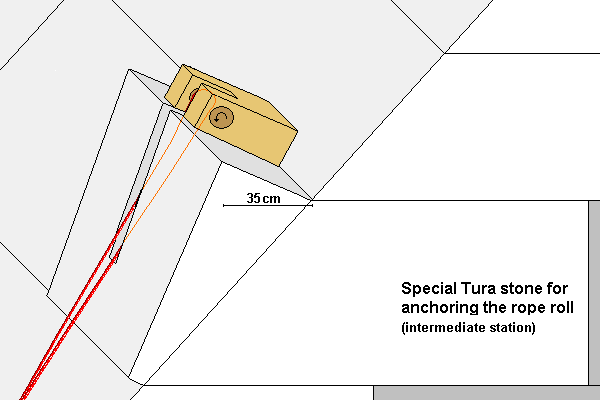
Not on the drawing: rope roll is additionally tied down with ropes or encased with wood.
A slit is chiseled into the stone just underneath the rope roll, so the
rope going to the sledge doesn't chafe. Tura stone is a soft limestone
and can be worked easily but after some time becomes harder when exposed
to air. After finishing the pyramid by laying the pyramidion on its top,
these stone bosses are chiseled off and the stone smoothed.
![]() Quarrying stones for the pyramid
Quarrying stones for the pyramid
On stretches with a slight gradient (5° or more), for example from the quarries to the foot of the pyramid or from the harbor to the pyramid, tracks with rope roll stations are installed as well, but only every 75 meters, so much longer ropes were used for hauling. Here it is much easier to anchor the rope rolls, all you have to do is place a pole next to it and anchor it with ropes.
 Starting at the foot of the pyramid
Starting at the foot of the pyramid
The stone blocks in the lower 10 courses were the largest - 1m by 2.5m and 1-1.5m high and weighting 6.5 - 10 tons [2]. They were built around the rock outcropping in the middle which goes up to at least 7m.
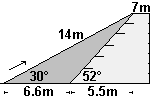 For
the first 7 meters (= 6 stone layers) it was not yet
possible to build the tracks directly on the pyramid flank, because the
sledges were too long to position correctly for starting. For these few
meters, small auxiliary ramps had to be built. Thanks
to using rope rolls for hauling, these ramps can be built much steeper,
than is normally suggested by Egyptologists for transport ramps. Instead
of 5 to 10° these ramps could be up to 30° steep. A rope roll
station was placed on the edge of the pyramid and the ramps, each with
tracks installed on top, were leading up to the plateau. Such an auxiliary
ramp would only be 12m long at the base - the ramp was protruding 6.6
meters onto the pavemenet at the pyramid base.
For
the first 7 meters (= 6 stone layers) it was not yet
possible to build the tracks directly on the pyramid flank, because the
sledges were too long to position correctly for starting. For these few
meters, small auxiliary ramps had to be built. Thanks
to using rope rolls for hauling, these ramps can be built much steeper,
than is normally suggested by Egyptologists for transport ramps. Instead
of 5 to 10° these ramps could be up to 30° steep. A rope roll
station was placed on the edge of the pyramid and the ramps, each with
tracks installed on top, were leading up to the plateau. Such an auxiliary
ramp would only be 12m long at the base - the ramp was protruding 6.6
meters onto the pavemenet at the pyramid base.
At least five such ramps, built solidly with smaller stone blocks and
with tracks installed on top had to be built (if you use more track systems,
for example on all sides of the pyramid, you would need more small ramps).
Franz Löhner thinks, that at the latest when building the 7th or
8th course (height ≈ 8-9m), it was better to dismantle the
auxiliary ramps and start hauling the sledges up directly on
the pyramid flank.
![]() Overview pyramid building
Overview pyramid building
![]() At
the foot of the pyramid the abrupt change from plane ground to
the 52° inclination had to be planned well. It was important,
that the sledge should lie on the rail with its rear and not its front
cross piece. To achieve this, a small layer up to about 2m height had
to be laid down, slightly curved upward toward the flank and the tracks
laid down on top. This layer (not a ramp), although not very high had
to be very stable, since it had to hold during the rest of the construction
time. Thanks to the slight curve, the sledge was able to surmount the
transition from plane ground to the flank without stopping and restarting.
At
the foot of the pyramid the abrupt change from plane ground to
the 52° inclination had to be planned well. It was important,
that the sledge should lie on the rail with its rear and not its front
cross piece. To achieve this, a small layer up to about 2m height had
to be laid down, slightly curved upward toward the flank and the tracks
laid down on top. This layer (not a ramp), although not very high had
to be very stable, since it had to hold during the rest of the construction
time. Thanks to the slight curve, the sledge was able to surmount the
transition from plane ground to the flank without stopping and restarting.
 Changing ropes at the intermediate rope roll station
Changing ropes at the intermediate rope roll station
 If
you wanted to haul up one stone per minute, at least five tracks leading
up the pyramid had to be installed. The largest quantity of stones had
to be transported at the beginning, later when building progressed further
up towards the top of the pyramid, the track systems were reduced to a
single track leading up to the very top (=146.59m). There was an intermediate
rope roll station consisting of two rope rolls installed on special Tura
stones every 30-37m. One hauling team (Franz Löhner calculates a
team of 48 haulers and 7 helpers = 55 men) was responsible for one leg
of the route. From 30m height down the pyramid flank they had to walk
a distance of 38 meters - at normal walking pace this would take them
2 minutes. As soon as one team has reached the foot of the pyramid the
next team can start above, so on each track system a stone arrives about
every 4 to 5 minutes - with five track systems working we achieve
the required one stone per minute (if the pyramid is finished
in 20 years). With additional track systems, for example installed on
the other lateral surfaces of the pyramid, it would be possible to increase
the output and thus reduce the time for building considerably.
If
you wanted to haul up one stone per minute, at least five tracks leading
up the pyramid had to be installed. The largest quantity of stones had
to be transported at the beginning, later when building progressed further
up towards the top of the pyramid, the track systems were reduced to a
single track leading up to the very top (=146.59m). There was an intermediate
rope roll station consisting of two rope rolls installed on special Tura
stones every 30-37m. One hauling team (Franz Löhner calculates a
team of 48 haulers and 7 helpers = 55 men) was responsible for one leg
of the route. From 30m height down the pyramid flank they had to walk
a distance of 38 meters - at normal walking pace this would take them
2 minutes. As soon as one team has reached the foot of the pyramid the
next team can start above, so on each track system a stone arrives about
every 4 to 5 minutes - with five track systems working we achieve
the required one stone per minute (if the pyramid is finished
in 20 years). With additional track systems, for example installed on
the other lateral surfaces of the pyramid, it would be possible to increase
the output and thus reduce the time for building considerably.
![]() Numbers and figures of the Cheops-pyramid
(pyramid of Khufu) (one stone per minute)
Numbers and figures of the Cheops-pyramid
(pyramid of Khufu) (one stone per minute)
![]() Detailed calculations how many workers
were necessary to build the pyramid
Detailed calculations how many workers
were necessary to build the pyramid
Just before each intermediate station the ropes attached to the sledge
had to be changed from one hauling team to the next one. The best solution
is to do that, while the sledge is still moving. Every
time the sledge has to be stopped and restarted you have to overcome the
static friction (stiction) between sledge and tracks.
Changing ropes at the uppermost station was more complicated and had to
be monitored by specially competent overseers.
![]() Illustration
of rope roll station and tracks on the pyramid flank
Illustration
of rope roll station and tracks on the pyramid flank
A hauling team on the pyramid flank starts up at the intermediate rope roll station and walks down the ladder-like rig thus pulling up the sledge with the stone. Just before the sledge reaches the intermediate station, the ropes are changed. The second hauling team waits up at the second station and now starts to walk down, thereby pulling the sledge up further.
When the second hauling team takes over, the rope of the first team is
lowered down to the sledge waiting at the foot of the pyramid. A second
hauling team which is standing by waiting, now takes over the hauling,
while the first team starts walking up the pyramid to the first intermediate
station. So for each leg of 35 meters there are two hauling teams
assigned.
![]() Detailed calculations how many workers
were necessary to build the pyramid
Detailed calculations how many workers
were necessary to build the pyramid
 Rope roll stations at the pyramid edge
Rope roll stations at the pyramid edge
The last rope roll station, the one at the top of the frustum of pyramid, was positioned on the very edge. This station looks very similar to the intermediate stations, only that here a large and broad Tura stone (2) with two rope rolls (1a and 1b) protrudes out over the edge to the pyramid plateau. A third rope roll (3) is placed about one and a half meters back on the plateau and anchored by another protruding stone (4) and some poles rammed into the stone underneath.
The ropes attached to the sledge (red) lead up and over the first rope roll (1a) and then underneath the second rope roll (3). Then they lead back over the rope roll at the edge (1b) and to the hauling team. This kind of arrangement prevents, that the special outer Tura stone (2) tilts and is pulled from its place.
 Arrival of the stones on the pyramid plateau
Arrival of the stones on the pyramid plateau
At the edge of the pyramid plateau the hauling team has to be specially cautious, because the heavy stone has to be tilted from the slanting flank to level ground and could possibly hit the edge. This has to be avoided at all costs. At the second to last rope roll station, the main hauling ropes (red) are attached to the sledge not in front but on the cross pieces in the back of the sledge. An overseer is positioned at the edge and is giving precise instructions, how fast the haulers had to pull and when to stop. In such a way the tilting is controlled precisely.

Rope rolls and the tura stone is shown enlarged, so it is clear where the ropes are. A - these are actually two rope rolls lying one behind the other (see above)
The ropes are attached to the sledge on both sides as follows: The main rope (red) goes from the cross piece in the back over the first rope roll (A), then around an additional rope roll (B) on the plateau and back over the first rope roll (A) to the hauling team which is walking down the pyramid flank. A second rope (blue) is attached to the cross piece in front of the sledge and leads directly between the two rope rolls over the edge. This rope is pulled by a second hauling team, that walks horizontally on the pyramid plateau. The edge is well protected by a cross beam (C), so the stone positioned underneath is not chipped or otherwise damaged by the many sledges arriving here.

When the sledge arrives on the edge, it is pulled further, until it protrudes over the edge. Now it would normally tilt and hit the edge.

1 = two rope rolls (enlarged) anchored on a special Tura stone (2) / 3 = rope roll (enlarged) anchored with stone (4) / 5 = lengthened cross piece, anchored by two protruding stones (6) / 7 = rail / 8 = stone on sledge / 9= toggle, to adjust the tension of the rope (green). Hauling ropes are not shown.
To avoid that the sledge hilts the edge there is a rope (green) stretched between the two stones where the rope rolls are anchored atop. The sole purpose of this rope is to absorb and cushion the movement of the sledge. A worker stands by and is adjusting the tension of the rope with a toggle (illustration = 9). The sledge with the stone block on top is slowly tilted and through adjusting the tension of the rope across it can be lowered precisely to the ground.
 Laying the stones on the pyramid plateau
Laying the stones on the pyramid plateau
It is important, that the work on the pyramid plateau can progress smoothly and well coordinated. The stones have to be delivered in the correct order and the route to the place were they are set down has to be free of obstacles. No time could be wasted - one stone per minute was arriving on top and had to laid down immediately!
Now the hauling teams pull the sledge (with the stone tied on top) on tracks on the pyramid plateau to its intended place. Now, and not earlier, the stone is removed from the sledge and with the help of levers laid accurately at its final location.
The wooden tracks on the plateau are built in such a way, that they can be moved about, so the whole surface can be reached easily. The plateau is relatively flat, but even here it is better to use tracks, so there is as little friction between the sledges and the surface area on which they glide. On level ground we need only a hauling team of 12 men for a 2.5 tons block.
The sledge is now brought back to the edge of the pyramid,
attached to a long rope and let sliding down the pyramid side. From the
foot of the pyramid it is brought back to the quarry, where the next stone
is attached to it and the next journey begins.
![]() Transporting the stone blocks using a sledge
on tracks
Transporting the stone blocks using a sledge
on tracks
Franz Löhner remarks, that specially long stones, so called headers, that are put down, so they reach deep into the inner stone layers, can also be tied down on the sledge not lengthwise but widthwise and transported like that. Stones, that had to reach positions to the left and right of the rope roll station could also be hauled up widthwise. After having arrived on the plateau they didn't have to be turned by 90° with levers but could be transported straight away to their positions (on track), thus gaining time.
How to lay down all those stones had to be planned minutely.
For the outer casing probably the corner stones and some stones in the
very middle of the pyramid side were set first. Specially large stones
were used, so called headers. From these three fixed
points the position of the other stones could be precisely determined
[1]. Since the outer stones was bevelled to the
exact angle at the quarry, only the position and their exact placement
had to be controlled.
![]() The outer casing stones of the pyramid
The outer casing stones of the pyramid
 Safety
Safety
On the pyramid building site there were many risks - haulers can stumble and fall down, ropes can rip and stones can tumble down and other materials used, for example the cross pieces of the sledges or the rope rolls can break. But this kind of risk can be minimized with appropriate controls. Since freemen and not slaves worked on the building site, these kind of risks were surley minimized as much as possible - with a strict control of material and good training for the workers.
 While
the sledge moves up the flank, two experienced men are safeguarding the
transport. Levers are used behind and to the side, for
example to adjust the direction the sledge is taking or if it is necessary
to stop for a short moment. If the sledge has to be stopped for a longer
amount of time, a stopping device in the form of a wooden
triangle is inserted between the cross beam of the sledge and one of the
cross piece of the track. The ladder-like rig is secured by a guardrail
made from ropes, so falls can be prevented.
While
the sledge moves up the flank, two experienced men are safeguarding the
transport. Levers are used behind and to the side, for
example to adjust the direction the sledge is taking or if it is necessary
to stop for a short moment. If the sledge has to be stopped for a longer
amount of time, a stopping device in the form of a wooden
triangle is inserted between the cross beam of the sledge and one of the
cross piece of the track. The ladder-like rig is secured by a guardrail
made from ropes, so falls can be prevented.
What happens, if the maximum credible accident happens? In the worst case scenario a roll breaks or a rope roll is pulled from its anchoring - now the whole weight is deflected to the second rope roll. The whole sledge with the stone moves to one side and hangs just on one rope roll, but since the two rope rolls are not very far apart, the sledge is still lying on top of the tracks. Rope roll and ropes are strong and big enough, that they can - for a short time - bear double load, so the worst disaster doesn't happen immediately. But the hauling team, that was pulling on one side will loose their footing, while the other team might be jerked up.
Since the ladder-like rig is quite small and with a guardrail, the men
still have a good chance to hold onto it. They don't wear any constricting
harness, so the crossbar handle
can just be let go if in danger. Of course the remaining hauling team
can not hold the sledge with the stone, but they probably were able to
retard and brake its movement, so the men safeguarding the sledge might
be able to insert the stopping device or some levers. Only if that cannot
be achieved, the block will tumble down the pyramid flank.
![]() Illustration
of rope roll station and tracks on the pyramid flank
Illustration
of rope roll station and tracks on the pyramid flank
 Sources
Sources
These methods for building the pyramids were first published 1993 in the book "Der Bau der Cheops-Pyramide" by Heribert Illig and Franz Löhner.
[1] W. Petrie The Pyramids and Temples of Gizeh
| Copyright 2006: |
Franz Löhner www.cheops-pyramide.ch | |
| Concept and Design, English Texts: |
Teresa (Zubi) Zuberbühler www.starfish.ch |
